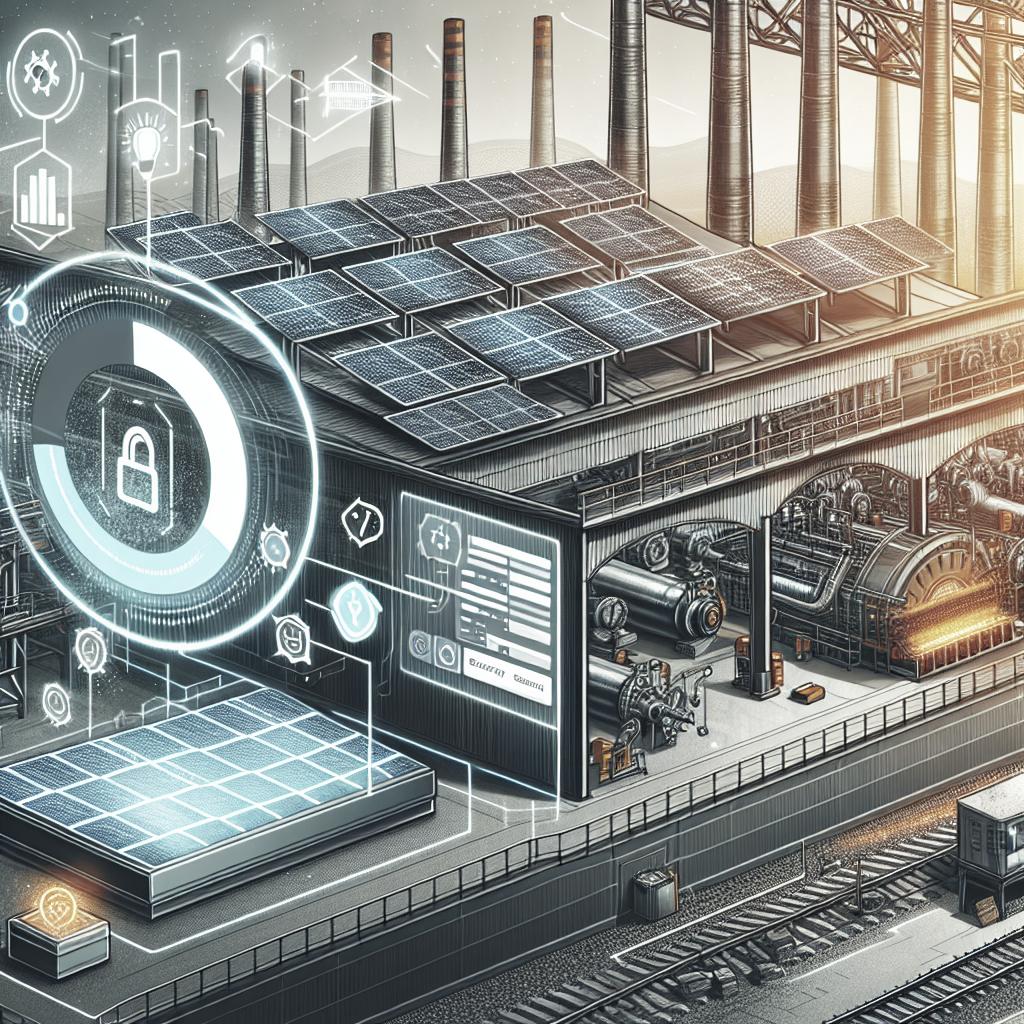<>
Introduction
The role of renewable energy in metal refining is becoming increasingly pivotal in a world striving for sustainable development. Metal refining processes are notably energy-intensive, often reliant on conventional fossil fuels that generate significant carbon emissions. Incorporating renewable energy sources like solar, wind, biomass, and geothermal energy can help mitigate environmental impacts and improve the overall efficiency of these industrial operations. This blog delves into the importance of renewable energy integration in metal refining, exploring key energy sources, opportunities for integration, and the challenges faced. Additionally, we spotlight case studies demonstrating successful implementation, providing valuable insights into the industry’s shift towards a greener future.
The Importance of Renewable Energy Integration
Renewable energy integration is crucial for reducing the carbon footprint of the metal refining industry. Traditional methods of metal refining are heavily dependent on fossil fuels, contributing to air pollution and greenhouse gas emissions. By incorporating renewable energy sources, refineries can significantly cut down these emissions, helping to combat climate change and adhere to stricter environmental regulations. Moreover, the adoption of renewable energy can lead to cost savings in the long run. While the initial investment in renewable infrastructure may be high, the lower operating costs and declining prices of renewable technologies offer economic benefits. Additionally, energy diversification can enhance the resilience of metal refineries against volatile fossil fuel markets, ensuring more stable and predictable energy costs.
Key Renewable Energy Sources for Refineries
1. Solar Energy
Solar energy, harnessed through photovoltaic (PV) panels and concentrating solar power (CSP) systems, offers a clean and sustainable option for metal refineries. PV panels convert sunlight directly into electricity, while CSP uses mirrors to focus sunlight and generate thermal energy for industrial processes. Solar energy can be particularly effective in regions with high sun exposure, providing a reliable source of power for refineries. The scalability of solar energy systems makes them adaptable to various refinery sizes and requirements. Additionally, advancements in solar technology have led to improved efficiency and reduced costs, making solar energy a viable option for more refineries. Solar energy not only helps in reducing emissions but also aligns with corporate sustainability goals.
2. Wind Energy
Wind energy is another promising renewable source for metal refining operations. Wind turbines convert kinetic energy from the wind into electrical power, which can be used to meet the energy demands of refineries. Wind farms can be established in suitable geographical locations with consistent wind patterns, ensuring a steady supply of power. One of the main advantages of wind energy is its low operational cost once the infrastructure is in place. The integration of wind energy can contribute to significant reductions in greenhouse gas emissions and offer long-term economic benefits. Furthermore, combining wind energy with other renewable sources can create a more balanced and reliable energy mix for refineries.
3. Biomass and Biogas
Biomass and biogas represent renewable energy sources derived from organic materials, such as agricultural waste, wood, and even municipal solid waste. These materials can be converted into bioenergy through various processes, providing a sustainable alternative to fossil fuels. In metal refining, biomass and biogas can be used for generating heat and electricity, reducing reliance on coal or natural gas. The utilization of biomass and biogas not only offers environmental benefits by decreasing carbon emissions but also promotes waste management and recycling. These renewable sources can be particularly advantageous in regions with abundant organic waste resources, turning potential waste problems into valuable energy solutions.
4. Geothermal Energy
Geothermal energy harnesses the natural heat from the Earth’s core to generate electricity and thermal energy. This renewable source is highly reliable, providing a consistent and stable energy supply, independent of weather conditions. Geothermal power plants can be located in regions with significant geothermal activity, offering a steady flow of energy for metal refining processes. The integration of geothermal energy can lead to substantial reductions in greenhouse gas emissions and enhance the sustainability profile of metal refineries. Moreover, geothermal energy provides base-load power, meaning it can continuously supply energy, making it an ideal complement to intermittent renewable sources like solar and wind.
Opportunities for Integrating Renewable Energy
1. Hybrid Energy Systems
Hybrid energy systems combine multiple renewable energy sources to create a balanced and reliable power supply for metal refineries. By integrating solar, wind, biomass, and geothermal energy, refineries can mitigate the intermittency issues associated with individual renewable sources. For instance, solar and wind can complement each other, with solar panels generating power during the day and wind turbines typically being more effective at night. These systems can be customized to fit the specific energy needs and geographical conditions of each refinery. Hybrid systems offer flexibility and scalability, making them suitable for both large and small operations. Additionally, they enhance energy security and stability, ensuring that refineries have access to continuous and reliable power.
2. Energy Storage Solutions
Energy storage solutions, such as batteries, thermal storage, and pumped hydro storage, play a critical role in the integration of renewable energy. These technologies store excess energy generated during peak production times and release it during periods of low production or high demand. In metal refining, energy storage can help manage fluctuations in renewable energy supply, ensuring a stable and continuous power flow. Advanced energy storage systems enhance the efficiency and reliability of renewable energy sources, making them more viable for industrial applications. The adoption of energy storage solutions can lead to more effective utilization of renewable energy, improving the overall sustainability and cost-effectiveness of metal refining operations.
3. Power Purchase Agreements (PPAs)
Power Purchase Agreements (PPAs) are contracts between energy producers and consumers, allowing metal refineries to procure renewable energy at predetermined rates. PPAs provide a cost-effective and risk-free way for refineries to access renewable energy, without the need for substantial upfront investments in infrastructure. Through PPAs, refineries can lock in long-term energy prices, protecting themselves from market volatility and ensuring stable operating costs. These agreements also support the growth of the renewable energy sector by providing a guaranteed market for energy producers. PPAs can be tailored to meet the specific energy needs and sustainability goals of refineries, making them a practical tool for integrating renewable energy.
Challenges in Integrating Renewable Energy
1. High Initial Costs
One of the most significant challenges in integrating renewable energy is the high initial investment required for infrastructure development. The installation of solar panels, wind turbines, geothermal plants, or biomass facilities involves substantial capital expenditure. Metal refineries need to weigh these costs against the long-term benefits and potential savings on operational expenses. While government incentives and subsidies can help offset some of these costs, the financial burden remains a barrier for many refineries. Access to financing and favorable economic conditions are crucial for facilitating the transition to renewable energy. Effective planning and strategic investments are necessary to overcome the challenge of high initial costs.
2. Technological Integration
Integrating renewable energy into existing refinery operations requires significant technological adjustments. Renewable energy systems need to be compatible with the current infrastructure, and any changes must ensure minimal disruption to production processes. This can involve complex engineering and technical expertise, posing a challenge for seamless integration. Additionally, the adoption of new technologies requires training and upskilling of the workforce to operate and maintain renewable energy systems. Refineries must invest in education and workforce development to ensure a smooth transition to renewable energy. Technological integration is a multifaceted challenge that requires careful planning and execution.
3. Intermittency and Reliability
The intermittency of certain renewable energy sources, such as solar and wind, poses a challenge for maintaining a consistent energy supply. Metal refining processes require a reliable and continuous power flow, which can be difficult to achieve with variable energy sources. Developing strategies to manage power fluctuations is essential. Using hybrid energy systems and energy storage solutions can help address the intermittency issue. However, these solutions require additional investments and technological advancements. Ensuring the reliability of renewable energy sources is critical for their successful integration into metal refining operations.
4. Regulatory and Permitting Issues
Regulatory and permitting issues can hinder the adoption of renewable energy in metal refining. The development of renewable energy projects often involves navigating complex regulatory frameworks and obtaining numerous permits. These processes can be time-consuming and costly, delaying the transition to renewable energy. Government policies and regulatory support play a crucial role in facilitating renewable energy adoption. Streamlining the permitting process and providing clear guidelines can help overcome these challenges. Advocacy and collaboration with regulatory bodies are essential for creating a conducive environment for renewable energy integration.
Case Studies in Renewable Energy Integration
Shell’s Moerdijk Chemical Plant
The Shell Moerdijk Chemical Plant in the Netherlands has made significant strides in integrating renewable energy into its operations. Utilizing a combination of solar and wind energy, the plant has reduced its reliance on fossil fuels and cut down carbon emissions. The implementation of energy-efficient technologies and energy storage solutions has further optimized the use of renewable energy. Shell’s commitment to sustainability is evident in its investment in renewable energy projects and infrastructure. The success of the Moerdijk Chemical Plant serves as a model for other refineries looking to adopt renewable energy solutions, demonstrating the feasibility and benefits of such initiatives.
Chevron’s San Joaquin Valley Operations
Chevron’s San Joaquin Valley operations in California have embraced renewable energy through the use of solar and geothermal power. The installation of solar panels and the utilization of geothermal resources have enabled Chevron to reduce greenhouse gas emissions and improve energy efficiency. The integration of these renewable sources has also contributed to cost savings and enhanced operational resilience. Chevron’s approach underscores the importance of diversifying energy sources and investing in sustainability. The success of the San Joaquin Valley operations highlights the potential for renewable energy to transform the energy landscape of metal refining.
ExxonMobil’s Baytown Complex
ExxonMobil’s Baytown Complex in Texas has implemented several renewable energy initiatives to reduce its environmental impact. The complex has incorporated solar and wind energy, along with energy storage systems, to create a more sustainable energy profile. These efforts have resulted in significant reductions in carbon emissions and operational costs. ExxonMobil’s Baytown Complex exemplifies the potential for large-scale refineries to successfully integrate renewable energy. The case study showcases the benefits of renewable energy adoption and provides valuable insights for other refineries aiming to transition to cleaner energy sources.
Final Thoughts
The integration of renewable energy in metal refining holds immense potential for transforming the industry into a more sustainable and environmentally friendly sector. By leveraging various renewable sources and overcoming the associated challenges, refineries can achieve significant reductions in carbon emissions and enhance operational efficiency. The case studies of Shell, Chevron, and ExxonMobil illustrate the practical benefits and feasibility of renewable energy adoption in metal refining. As the industry continues to innovate and embrace renewable energy, it will play a crucial role in driving global sustainability efforts.
| Subheading | Content Summary |
|---|---|
| Introduction | Overview of the importance and benefits of integrating renewable energy into metal refining. |
| The Importance of Renewable Energy Integration | Discusses the environmental and economic benefits of adopting renewable energy in metal refining. |
| Key Renewable Energy Sources for Refineries | Explores solar, wind, biomass, and geothermal energy as viable renewable sources for refineries. |
| Opportunities for Integrating Renewable Energy | Covers hybrid energy systems, energy storage solutions, and power purchase agreements (PPAs) as key opportunities for integration. |
| Challenges in Integrating Renewable Energy | Highlights high initial costs, technological integration, intermittency and reliability, and regulatory issues as challenges. |
| Case Studies in Renewable Energy Integration | Showcases successful examples from Shell, Chevron, and ExxonMobil in integrating renewable energy into their operations. |
| Final Thoughts | Summarizes the potential and benefits of renewable energy in metal refining, emphasizing the industry’s role in promoting sustainability. |


